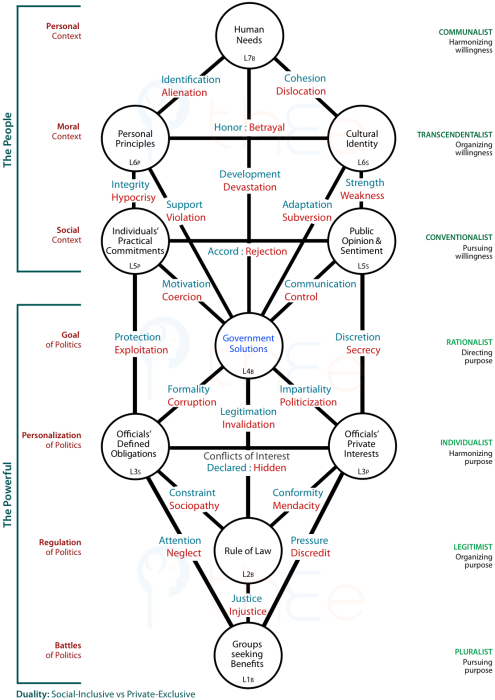The Power and Responsibility of the People
Perhaps the most interesting aspect of the analyses is the part that «» play in government choices and political life generally. The power-structure of society is based in organized groups. Yet all significant change for any particular person or community is dependent on generally.
The initial assumption and final conclusion cannot be avoided: the final responsibility for the political condition of any society must rest with the people. That refers to their general level of awareness, degree of ethical maturity in society, and general strength of character. This phenomenon is examined further here by comparing the two Trees in . The process of discovering these Trees has been summarized: note that one emerges from the structure of the other.
These two similar Trees in , have been tentatively named:
- .
Naming of Trees is rarely easy. We can refer to these two Trees via their structure or via their internal duality.
Via Structure:
The Spiral Tree (CH-Tree) and
the Structural Hierarchy Tree (CsH-Tree)
are shown side by side below without Channel names.
Via Internal Duality:
The CH-Tree depicts the relations and influences between and in society.
The CsH-Tree depicts states and processes in through .
![]() The CH-Tree exists inside the CsH-Tree
The CH-Tree exists inside the CsH-Tree
Assuming not too many errors, names of the Centres and the progression of Levels (shown on the side of each Tree) should help get our minds around what is being represented.
Better viewing: Use browser zoom if needed.
| PH'6CHK: The Powerful and the People Making Political Choices |
PH'6CsHK: The People and the Sources of Power Legitimation of Politics |

|

|
Both are about «», but they handle this differently as shown by their components. The Centres may seem rather alike, but they are unequivocally different: () are not the same as ().
The internal duality of the is:
Social Life as context for Political Life
i.e. The People v The Powerful
The internal duality of the is:
Change in Society as context for Participation in Politics
i.e. Sources of Power v The People.
The differing positions of «the people» in these —at the top of one and the bottom of the other—confirm the assumptions with which the inquiry into commenced.
Although «the people» cannot do much to influence «the powerful» in society as regard to ordinary government choices (), «the people» are, potentially at least, the powerful ones when it comes to generating any significant change. They control the «sources of power» in society, if they but choose to recognize that.
seems to be primarily a matter of () on the part of the people en masse to claim and assert both responsibility and power.
The maps what can, does and should govern choices for a society. It gives no indication how people in society can participate or what drives changes.
«Power and the Powerful» form the basis. We note that the extremes of at can be progressively brought under control, more or less,
- by -,
- the -, and
- even -
but the corrupting influence of of on is so strong that all 3 Levels easily combine to give the powerful even more power.
«The People» in the are represented:
- initially as a mass, the social context of . This is something too diffuse to act but still weighty in its effects, including being able to affect ;
- then by the moral context of whose regulatory effects often seem to be silent or to dominate in a ways that may seem irrational or wrong to outsiders; and
- finally, the personal context of , which take the form of everyone finding ways to work, associate and transact for themselves and others in their community.
Given that most human needs are better managed through people acting and associating on their own behalf privately, the seem to be determined primarily by Centres in the lower half of the —where individuals are directly involved () and groups struggle self-interestedly ().
Solutions chosen by governments appear to be dominated by and , combined with parochial with corruption varying according to local norms.
Sometimes particular manifest forcibly and «compel» a government to act. More often, government action is justified in terms of . But whenever such action displaces private activity and encourages reliance on government, moral hazards are generated.
The is a picture of how political tensions need to be handled. It shows how (in principle) people can and should participate so as to determine choices and changes in society. It gives no indication of the forces that affect how people think about politics and look after themselves.
«The People» form the basis in this . Every member is viewed as an autonomous agent with a dependence on and hence a commitment to society. So each of us must recognize . However, the involvement of people in politics is quickly limited by inherent difficulties:
- the demands of can be unpleasant in the extreme;
- efforts in are time-consuming and exhausting;
- there is complexity inherent in
Nevertheless, genuine entails a readiness for if the views of The People are ever to prevail.
«Power and the Sources of Power» emerge …
- initially as the ; and then
- controlled by a inherent in society-as-a-whole; and finally
- by recognized by everyone but difficult to alter.
Within , conflict develops between tensions emerging from discontents and action, leading (ideally) to peaceful but forceful participation. Pressures play out in part by influencing , and partly by generating greater by the people involved.
The stage of maturation of political institutions probably plays the dominant role in both the quality of policy proposals and the process by which proposals are developed and appraised.
Originally posted: August-2009; Last updated: 15-Nov-2010